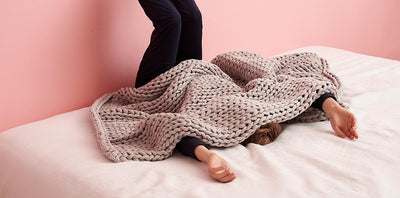How to Keep Different Fabrics Clean: Tips and Tricks From the Napperhood!
With so many sustainable fabrics to choose from here in the Napperhood, we’ve put together a comprehensive fabric care guide to give you a little more information about washing instructions for materials in general. Here’s our best advice for keeping your clothes (and curtains!) clean — from machine washable fabrics to handwash-only textiles.

Bearassentials
Natural fabrics sometimes require more careful cleaning, but they’re also more durable
Some synthetic fabric like Spandex also require delicate cycles when machine washed
Fabrics behave differently depending on the particular garment or textile, so it’s important to double-check your care labels before washing.
Did you know?
Denim is traditionally made of 100% cotton, but some denim is a cotton-synthetic blend.
Cleaning fabric is an often overlooked aspect of a sustainable, planet-friendly lifestyle. Following care instructions properly can help to maintain the appearance and structural integrity of your clothes, ensuring that they last longer and don’t need to be replaced.
Of course, you can always check the care labels on your fabrics to see how to wash them. But when it comes to cleaning different types of fabric, their information can feel overwhelming if you aren’t up to speed on the characteristics of the fabrics themselves.
When do you hand wash, and when do you line dry? How do you really know if something should only be dry cleaned? And what do you do if your clothes don’t even have a care label?
Knowing more about the materials themselves can help!
Cloth vs. fabric
There is not a significant difference between cloth and fabric, but technically, cloth is a type of fabric more commonly used for clothing, while fabric is a broader term used to describe a wide range of materials, from towels to wallpaper to carpets.
Cloth is a type of fabric made out of natural or synthetic fibers that are woven, felted, or knitted together. So when you learn how to keep fabrics clean in general, you’re also learning how to wash your clothes!
Which fabrics are easiest to wash?
The most easy-to-wash fabrics include cotton and synthetics such as polyester and nylon — but don’t confuse washability with sustainability! Often natural, sustainable fabrics that are gentle on the environment require a little extra care to stay as comfy as can be.
While they are often more delicate and require more care, sustainable natural fabrics pay off in other ways: they are gentler on your skin and more breathable, and when properly cared for, they’re also more durable and last longer.

Natural Fabrics
A fabric is considered a natural fabric if it is made of natural fibers. Natural fibers can come from a variety of sources including plants, animals, and even minerals. The important thing that sets them apart from synthetic fibers is that the raw materials are not man-made.
Here are our best tips for caring for some of the most common natural fabrics that you may come across from day to day.
Cotton / Organic Cotton
Cotton is soft, breathable, and easy to clean! The most important thing to watch out for when you’re washing cotton fabrics is shrinkage. You’ll want to check the label of your cotton fabric to see if it has been pre-shrunk.
Most cotton clothes are pre-shrunk, which means you can generally wash it in cold or warm water with a natural detergent. (We recommend using only natural, biodegradable detergents to keep your fabrics feeling their best.)
If your cotton fabric is not pre-shrunk, you’ll want to be extra careful and wash it in cold water so that it doesn’t shrink and the color doesn’t fade.
Our Cotton Napper weighted blankets are made using only 100% organic cotton, which uses up to 90% less water than conventional farming methods and is free from harmful chemicals, pesticides, synthetics, or artificial softeners.
To wash a cotton weighted blanket, be sure to wash separately in cold water, on a delicate or permanent-press cycle, using mild or eco-friendly detergent. Then tumble dry on low, ensuring that you dry for enough cycles for the blanket to fully dry. This should get you on your way to clean, cozy nap perfection!
Denim
Denim is just another kind of cotton! To make denim, you dye cotton fibers, then weave them together to create the familiar sturdy fabric.
While denim used to be 100% cotton, it is currently sometimes made with a blend of cotton and synthetic fibers — so you may want to check your care label to identify what your jeans are really made of.
It’s best to wash denim in cold water, and if you’re washing jeans, you’ll want to turn them inside out before washing them.
You’ll only want to wash jeans as often as needed, or every 3-10 wears, because the fabric is very thick, and washing them too often will cause them to unnecessarily wear down.
TENCEL™
Tencel™, one of the most sustainable fabrics on earth, is made of natural eucalyptus fibers. It’s naturally moisture-wicking and silky soft, which is why we use it to make our cooling Tree Napper weighted blanket!
To wash Tencel™, you’ll want to opt for the most delicate cycles and detergent. Be sure to check the care labels of your particular Tencel™ piece, and skip out on any bleach or fabric softener, which can damage the natural fabric.
Linen
Linen is made from flax, and because of its lightweight, summerlike texture, it’s used to make a wide range of textiles, from clothes to curtains to sheets.
With this natural material, the care instructions depend a lot on the garment itself. Some linen (like the organic Belgian flax linen we use to make our bolster pillow covers) is machine washable, and can be washed on a delicate cycle, then tumble dried on a low heat setting.
Other linen requires more care intensive cleaning and can only be hand washed and line dried — and still other linen can only be dry cleaned.
Linen sometimes appears wrinkled after washing, but if you need to iron it, you’ll want to make sure to use a low heat setting on your iron so as not to damage the natural fibers.
Wool
When people refer to wool, they’re usually talking about sheep wool — although the term wool technically means any natural fiber that comes from a mammal.
Wool is known for how well it insulates heat, and it is also one of the most care intensive natural fabrics. In fact, some wool garments are dry clean only, so be sure to check the care label before you start washing.
If your wool isn’t dry clean only, it’s best to hand-wash it in cold water. Sometimes you can wash wool in a washing machine if your washer has a very delicate wool cycle, but you should avoid machine drying wool, since machine drying can cause the fabric to lose its shape.
Instead of machine drying it, you can squeeze out water from your freshly-washed wool fabric, then lie it flat to air dry.
Cashmere
Cashmere is actually just another kind of wool! Cashmere is specifically made from goat hair, and is known for being an especially delicate, soft, and luxurious fabric.
When it comes to cleaning cashmere, dry cleaning is usually the best way to go. We recommend choosing a perc-free, eco-friendly dry cleaner to make sure the cleaning process is as easy on the planet as possible.
Silk
If you own real silk clothes or fabrics, you’ll want to be very careful with cleaning it to preserve the soft and delicate texture. Dry cleaning is recommended, but it’s also possible to hand-wash silk in cold water with a natural detergent.
The most important thing to remember when cleaning silk is to skip the dryer altogether. Let your silk fabric air dry outside of any direct sunlight to maintain its texture and appearance.

Synthetic Fabrics
Even when cleaning synthetic fabrics, it’s best to clean with care and use a mild, eco-friendly detergent that’s biodegradable. This helps to make sure that your fabric lasts as long as possible, and that your cleaning process is as easy on the planet as can be.
Polyester
All polyester is essentially made of plastic. There are many different types of polyester fabrics, but you can generally break them down into two categories when it comes to sustainability: virgin polyester, which creates new plastic, and recycled polyester, which repurposes old plastic into functional fabric.
All polyester is essentially made of plastic. There are many different types of polyester fabrics, but you can generally break them down into two categories when it comes to sustainability: virgin polyester, which creates new plastic, and recycled polyester, which repurposes old plastic into functional fabric.
However, it’s best to avoid high heat when ironing polyester: the synthetic fibers can actually melt.
Polyester Blends
When it comes to blends of polyester and natural fabrics, such as linen polyester blends, fabric care can be a little tricker. Try following the care instructions for the most delicate fabric included in the blend, and make sure to check individual care labels for specifics.
Spandex
Spandex is a synthetic fabric commonly used to make athletic wear. Because clothes made from spandex are often used for high impact activities, you’ll likely end up washing them very often to keep them fresh, but it’s important to take measures to prevent the fabric from losing its shape.
Spandex is known for its ability to stretch without losing its shape — so why does spandex shrink when dried? It all comes down to the high heat of the dryer. So when you wash spandex fabrics, you’ll want to choose a cold washing cycle and drying cycle to keep them stretchy for future activity.
Conclusion
Carefully cleaning your fabrics can help to extend the lifespan of your favorite clothes and household textiles. Most of the time, reading the care labels on your fabrics is the best way to learn the recommended cleaning methods, but understanding the real reasons behind those washing instructions can help you on your way to a cleaner, more comfortable, and more sustainable home.







